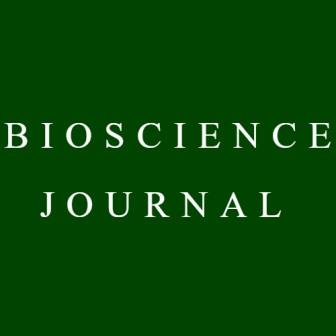Effect of reciprocating instrumentation on chlorhexidine substantivity on human dentin: chemical analysis followed by confocal laser microscopy
DOI:
https://doi.org/10.14393/BJ-v37n0a2021-54518Palavras-chave:
Chromatography, Enterococcus faecalis, Ex vivo, Human Tooth, Root Canal Preparation.Resumo
The present research analyzed the reciprocating instrumentation associated to chlorhexidine (CHX) substantivity as its correlation with E. faecalis viability in ex vivo root canals. Eighty extracted single-rooted human teeth were used, being 40 to high-performance liquid chromatography (HPLC) and 40 to confocal laser scanning microscopy (CLSM). In both, teeth were decoronated and the cervical third was prepared. In the CLSM analysis, the root canals were inoculated with E. faecalis for 14 days. Samples were divided into 4 groups (n=10) according to instrumentation technique: no instrumentation and irrigation with distilled water (control); manual instrumentation (K-File); rotary instrumentation (ProTaper Next); and reciprocating instrumentation (Reciproc R25). Two percent chlorhexidine was applied as irrigating substance in experimental groups. Longitudinal grooves resulted in 2 halves root and 20 proof bodies in each group. Samples were divided by chance in two groups (n=10) and the outcomes were evaluated after two days and one week. The retained chlorhexidine and live cells after instrumentation techniques in each evaluation time was measured by HPLC and CLSM, respectively. Specific analysis was applied for experimental tests (p≤0.05). Both rotary as well as reciprocating techniques significantly reduced the amount of chlorhexidine on dentin in all observation periods (p<0.05). After evaluation times, all experimental groups presented lower live cells compared to control, but without statistically difference. Intragroup comparisons in times of evaluation showed no differences in instrumentation techniques, in chlorhexidine retention and number of live cells (p>0.05). Reciprocating instrumentation does not interfere on chlorhexidine substantivity.
Downloads
Referências
ALVES, F.R.F., et al. Bacteria and hard tissue debris extrusion and intracanal bacterial reduction promoted by XP-endo shaper and Reciproc instruments. Journal of Endodontics. 2018, 44(7), 1173-1178. https://doi.org/10.1016/j.joen.2018.04.007
BÖTTCHER, D.E., et al. Evaluation of the effect of Enterococcus faecalis biofilm on the 2% chlorhexidine substantivity: an in vitro study. Journal of Endodontics. 2015, 41(8), 1364–1370. https://doi.org/10.1016/j.joen.2015.04.016
DAMETTO, F.R., et al. In vitro assessment of the immediate and prolonged antimicrobial action of chlorhexidine gel as an endodontic irrigant against Enterococcus faecalis. Oral Surgery, Oral Medicine, Oral Pathology, Oral Radiology and Endodontics. 2005, 99(6), 768–772. https://doi.org/10.1016/j.tripleo.2004.08.026
DAL BELLO, Y., et al. Effectiveness of Calcium and Sodium Hypochlorite in Association With Reciprocating Instrumentation on Decontamination of Root Canals Infected With Enterococcus Faecalis. Australian Endodontic Journal. 2019, 45(1), 92-97. https://doi.org/10.1111/aej.12289
GAVINI, G., et al. Resistance to flexural fatigue of Reciproc R25 files under continuous rotation and reciprocating movement. Journal of Endodontics. 2012, 38(5), 684-687. https://doi.org/10.1016/j.joen.2011.12.033
GOMES, B.P., LILLEY, J.D. and DRUCKER, D.B. Variation in the susceptibilities of components of the endodontic microflora to biomechanical procedures. International Endodontic Journal. 1996, 29(4), 235–241. https://doi.org/10.1111/j.1365-2591.1996.tb01375.x
GUELZOW, A., et al. Comparative study of six rotary nickel-titanium systems and hand instrumentation for root canal preparation. International Endodontic Journal. 2005, 38(10), 743–752. https://doi.org/10.1111/j.1365-2591.2005.01010.x
GUERREIRO-TANOMARU, J.M., et al. Comparative analysis of Enterococcus faecalis biofilm formation on different substrates. Journal of Endodontics. 2013, 39(3), 346-350. https://doi.org/10.1016/j.joen.2012.09.027
MOREIRA, D.M., et al. Structural analysis of bovine root dentin after use of different endodontics auxiliary chemical substances. Journal of Endodontics. 2009, 35(7), 1023–1027. https://doi.org/10.1016/j.joen.2009.04.002
NEVES, M.A., et al. Clinical antibacterial effectiveness of root canal preparation with reciprocating single-instrument or continuously rotating multi-instrument systems. Journal of Endodontics. 2016, 42(1), 25–29. https://doi.org/10.1016/j.joen.2015.09.019
RAN, S., et al. Assessment of dentinal tubule invasion capacity of Enterococcus faecalis under stress conditions ex vivo. International Endodontic Journal. 2015, 48(4), 362-372. https://doi.org/10.1111/iej.12322
RASIMICK, B.J., et al. Stability of doxycycline and chlorhexidine absorbed on root canal dentin. Journal of Endodontics. 2010, 36(3), 489–492. https://doi.org/10.1016/j.joen.2009.11.003
RICUCCI, D., LOGHIN, S. and SIQUEIRA Jr, J.F. Exuberant biofilm in- fection in a lateral canal as the cause of short-term endodontic treatment failure: report of a case. Journal of Endodontics. 2013, 39(5), 712–718. https://doi.org/10.1016/j.joen.2012.12.008
RÔÇAS, I.N., et al. Disinfecting effects of rotary instrumentation with either 2.5% sodium hypochlorite or 2% chlorhexidine as the main irrigant: a randomized clinical study. Journal of Endodontics. 2016, 42(6), 943–947. https://doi.org/10.1016/j.joen.2016.03.019
RÔÇAS, I.N. and SIQUEIRA Jr, J.F. Identification of bacteria enduring endodontic treatment procedures by a combined reverse transcriptase-polymerase chain reaction and reverse-capture checkerboard approach. Journal of Endodontics. 2010, 36(1), 45-52. https://doi.org/10.1016/j.joen.2009.10.022
SOUZA M.A., et al. Antimicrobial activity of hypochlorite solutions and reciprocating instrumentation associated with photodynamic therapy on root canals infected with Enterococcus faecalis - An in vitro study. Photodiagnosis and Photodynamic Therapy. 2018a, 23, 347-352. https://doi.org/10.1016/j.pdpdt.2018.07.015
SOUZA, M., et al. Evaluation of chlorhexidine substantivity on human dentin: a chemical analysis. Journal of Endodontics. 2012, 38(9), 1249–1252. https://doi.org/10.1016/j.joen.2012.06.003
SOUZA, M.A., et al. Effect of root canal preparation techniques on chlorhexidine substantivity on human dentin: a chemical analysis. Clinical Oral Investigations. 2018b, 22(2), 859-865. https://doi.org/10.1007/s00784-017-2162-7
VERSIANI, M.A., et al. Micro-computed Tomographic Evaluation of the Shaping Ability of XP-endo Shaper, iRaCe, and EdgeFile Systems in Long Oval-shaped Canals. Journal of Endodontics. 2018, 44(3), 489-495. https://doi.org/10.1016/j.joen.2017.09.008
WILLIAMS, J.M., et al. Detection and quantitation of E. faecalis by real-time PCR (qPCR), reverse transcription-PCR (RT-PCR), and cultivation during endodontic treatment. Journal of Endodontics. 2006, 32(8), 715-721. https://doi.org/10.1016/j.joen.2006.02.031
Downloads
Publicado
Como Citar
Edição
Seção
Licença
Copyright (c) 2021 Matheus Albino Souza, Fernanda Duda Bonatto, Afonso Cristiano Fleck da Silva, Ezequiel Santin Gabrielli, Felipe Trentin Motter, Larissa Piuco, Karen Barea de Paula Duarte, Charise Dallazem Bertol, Luciana Grazziotin Rossato-Grando, Carlo Theodoro Raimundy Lago, Doglas Cecchin, Juliane Bervian, João Paulo De Carli, Francisco Montagner

Este trabalho está licenciado sob uma licença Creative Commons Attribution 4.0 International License.






